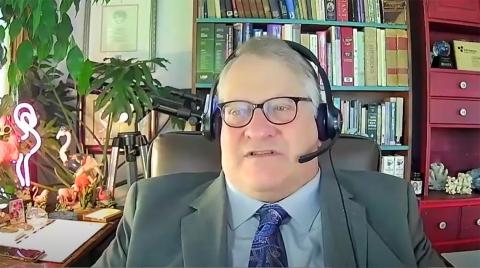ODS Turns 25
Symposium Highlights Dietary Supplements Research

Many Americans routinely use dietary supplements. From vitamins and minerals to herbal products, most adults report using supplements to improve or maintain their health.
But what does the science say? For more than 25 years, NIH’s Office of Dietary Supplements (ODS)—located in the Office of the Director—has been working to find out, supporting research on supplements to help confirm or refute health claims.
In 1995, when ODS was established, there was minimal research into the benefits or risks of dietary supplements. Back then, there were only about 4,000 products on the market. Today, there’s a staggering array of more than 80,000 products in what has grown into a nearly $56 billion industry.
Throughout the past year, ODS hosted several virtual events to celebrate its 25th anniversary, culminating in a 2-day symposium on supplements led by ODS acting director Dr. Joseph Betz.
Trends Across the Lifespan

More than half of U.S. adults take one or more dietary supplements regularly. Use increases significantly over time, with more than 70 percent of adults over age 65 taking them. Use is also high among other subgroups, such as pregnant women.
Prevalence data “indicate that micronutrients or vitamin and mineral supplements are the most commonly used products in the country,” said Dr. Regan Bailey, professor of nutrition and associate director of the Institute for Advancing Health through Agriculture at the Texas A&M University system.
About one-third of children take a micronutrient-containing supplement, mainly vitamins. In recent years, there’s been increased use of other types of supplements, such as melatonin, omega-3 fatty acids and probiotics, with the intention of improving sleep, reducing stress or promoting bowel health.

Photo: Shutterstock/Prostock Studio
Dietary supplement use varies by sex, race and ethnicity, educational attainment and income, as well as lifestyle factors such as physical activity. Among seniors who take supplements, 40 percent take a multivitamin, said Bailey, and nearly one-third take 4 or more supplements daily.
It’s important to report supplement use to health care providers, recommended Bailey. From a clinical and research perspective, “If we don’t include supplements in our total estimates of nutrient exposure,” she said, “we overestimate the proportion of the population at risk for inadequacy and we underestimate the proportion at risk for potentially excessive intakes.”
Eye Health
One NIH randomized clinical trial looked at whether a mix of specially dosed vitamins and minerals might reduce the risk of age-related macular degeneration (AMD), a leading cause of blindness.

The Age-Related Eye Disease Study (AREDS) was launched “at a time when a lot of studies were going on for cancer and cardiovascular disease,” said Dr. Emily Chew, chief of the Clinical Trials Branch at the National Eye Institute. “We as ophthalmologists latched onto that, and nutritional specialists helped us” with the formulations.
Investigators found that a combination of antioxidant vitamins A (beta-carotene), C and E along with zinc and small amounts of copper reduced the risk of progression to late-stage AMD over 5 years. “We also looked 10 years out and were surprised to find the beneficial effects persisted,” she said.
Building on the promising finding, NEI launched AREDS2, adding two plant-derived substances—lutein and zeaxanthin—as well as omega-3 fatty acids. The study found no benefit using omega-3s for the progression of AMD but lutein and zeaxanthin showed a significant benefit over beta-carotene. Going forward, investigators replaced the beta-carotene—which studies have shown increases lung cancer risk in smokers—with the more effective and safer lutein-zeaxanthin combination.
Cardiovascular Disease
Several NIH institutes collaborated with ODS on a large, randomized prevention trial studying the potential effects of vitamin D [2000 IU daily] and omega-3s [1 g daily] on cardiovascular disease (CVD) prevention. More than 25,000 people nationwide, including 5,100 African Americans, with a median age of 67 participated in this 5-year trial, called VITAL.

“A pattern was beginning to emerge by around 2012 that coronary events were more affected by omega-3 supplements than stroke,” said Dr. JoAnn Manson, a Harvard Medical School professor, chief of preventive medicine at Brigham and Women’s Hospital and director of VITAL. VITAL confirmed that hypothesis.
For study participants who received omega-3s, there was a 28 percent reduction in fatal and non-fatal myocardial infarctions (MIs) but no reduction in stroke, Manson said. Digging deeper, the most significant reduction occurred among African American participants—a 77 percent lower risk of MI.
Vitamin D did not reduce major CVD risk but suggested a reduction in cancer mortality, a finding that requires further study. Digging deeper, “those who were at normal or healthy weight did have a 24 percent significant reduction in the primary endpoint of total invasive cancer with vitamin D,” said Manson. However, she cautioned, “We strongly discourage mega-dosing with either of these supplements.”
Prostate Cancer
The National Cancer Institute has long studied the potential of dietary supplements to reduce the risk of different types of cancer. One such trial, selenium and vitamin E in cancer prevention (SELECT), was based on the reported anti-tumorigenic properties of these nutrients.

Focused on prostate cancer, the SELECT study recruited more than 34,000 men starting in 2001, intending to follow them for 12 years. The supplements were stopped, though, in 2008 after the data and safety monitoring committee for the trial found that administering selenium, an antioxidant, and/or alpha tocopherol, a form of vitamin E, did not reduce prostate cancer incidence. In fact, the alpha-tocopherol appeared to increase prostate cancer risk; follow-up with the study participants after a few more years confirmed this finding.
“We had at this point two basic scenarios of vitamins not only not preventing cancer but also potentially causing harm,” said Dr. Lori Minasian, deputy director of NCI’s Division of Cancer Prevention. Prior studies had pointed to beta-carotene’s link to lung cancer in smokers and then SELECT showed vitamin E increased prostate cancer risk.
SELECT continued as an observational cohort study and the ongoing collection of biospecimens inspired multiple collaborations, consortia and publications. Because of the high rate of use of multivitamins in the general public, SELECT investigators also developed a multivitamin without selenium and vitamin E. More than 90 percent of participants took the study multivitamins, providing an opportunity to explore other questions going forward.
ODS continues to support and collaborate on research evaluating the benefits and risks of dietary supplements, while updating consumer fact sheets, a dietary supplement label database and an ingredients database to inform consumers, health professionals and policymakers.
“Some dietary supplements do have health benefits, but others need more research to determine if they have value or if benefits outweigh risks,” said Betz. “We look forward to continuing to support scientific research on these products.”
For more information on the symposium, including links to the archived video recording, see: https://events-support.com/events/ODS_25th_Anniversary_Scientific_Symposium.
